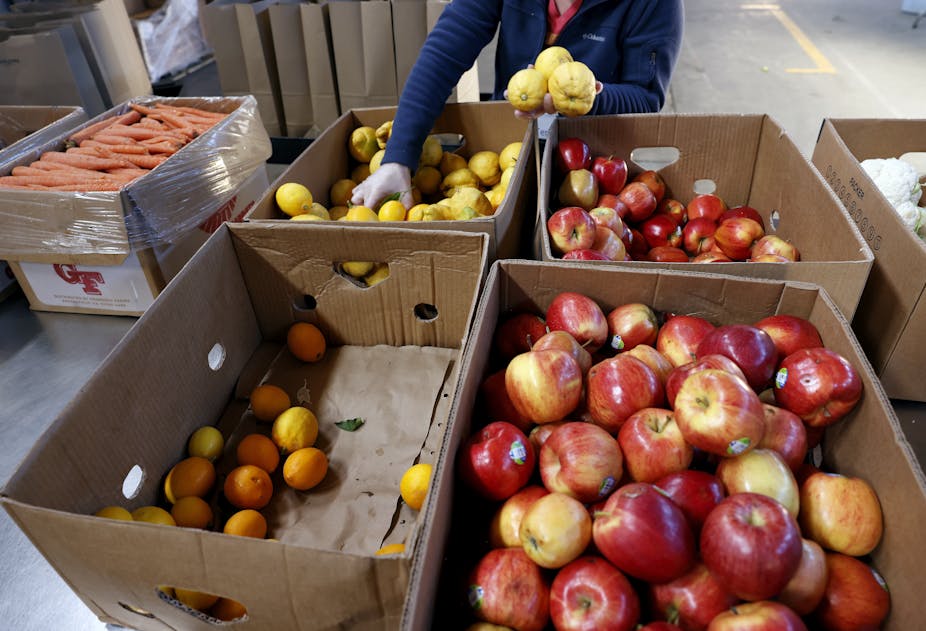In this week’s episode of The Conversation Weekly, we look at some of the reasons behind racial disparities in U.S. food insecurity and hear from experts with their suggested solutions. And the discovery of the bones of a small child, carefully buried in Kenya 78,000 years ago, gives us a peek into the minds of ancient humans.
Before the pandemic hit, official food insecurity rates in the U.S. were at an all-time low. But there was a big racial divide. In 2019, the official food insecurity rate for Black people was 19% – more than twice as high as it was for white people at just under 8%. It was just under 16% for Hispanic people.
To find out why, and what’s been going on during the pandemic, we’ve talked to three experts who study food insecurity and food justice. They’ve all written for The Conversation in recent months as part of a series examining why so many people in the U.S. struggle to provide nutritious meals for themselves and their families.
There is a federal program, the Supplemental Nutrition Assistance Program (SNAP), that provides support to those who are struggling to get enough food. But for those who aren’t eligible or who still don’t get enough support, many turn to food pantries. Caitlin Caspi, associate professor in the Department of Allied Health Sciences at the University of Connecticut, explains that “food pantries are often located in areas with a high proportion of Black and Hispanic residents”. She explains how central they have become to the lives of so many people.
Craig Gundersen, professor of agricultural and consumer economics at the University of Illinois at Urbana-Champaign projects that food insecurity rates will have increased during 2020, before falling back slightly in 2021. And his analysis suggests the situation will improve more slowly for Black people than white people. He says the situation is not the same across the country: “Black persons in the northern part of the country, especially in the upper Midwest, have really high rates of food insecurity; Black persons in the southern part of the United States have rates that are more akin to what we see in other populations.”
Read more: The pandemic recession has pushed a further 9.8 million Americans into food insecurity
Julian Agyeman, professor of urban and environmental policy and planning at Tufts University, tells us: “We cannot divorce hunger in the U.S. from racist, urban planning in our cities.” Agyeman explains how the legacy of racist covenants, redlining and exclusionary zoning in American cities has concentrated poverty in areas with predominantly Black populations. He says this has reduced access in these neighbourhoods for nutritious, reasonably priced food. To address these problems, Agymen says “we need to start with an analysis that really nails the problem”, and look to community projects such as urban agriculture initiatives as “a series of opportunities for local economic development”.
Read more: How urban planning and housing policy helped create 'food apartheid' in US cities
In our second story, we hear about a landmark discovery in south-eastern Kenya. Paleoanthropologists working at a dig in a cave called Panga ya Saidi spotted something unusual in the sediment. What they’d found was the remains of a child – and what turned out to be the oldest burial ever discovered in Africa. Maria Martinón-Torres, director of the Centro Nacional de Investigación sobre la Evolución Humana in Spain, one of the scientists involved, talks to us about her analysis of the discovery and what the research reveals about the ways our ancient ancestors approached death.
Read more: How we discovered the oldest human burial in Africa – and what it tells us about our ancestors
And Jonathan Este, international affairs editor at The Conversation in the UK, recommends some recent analysis by experts about the conflict in Israel-Palestine.
The Conversation Weekly is produced by Mend Mariwany and Gemma Ware, with sound design by Eloise Stevens. Our theme music is by Neeta Sarl. You can find us on Twitter @TC_Audio, on Instagram at theconversationdotcom. or via email on podcast@theconversation.com. You can also sign up to The Conversation’s free daily email here.
A transcript of this episode is available here.
News clips in this episode are from Yahoo Finance, CBS News, VOA News, Democracy Now, New York Times, BBC News and WCVB Channel 5 Boston.
You can listen to The Conversation Weekly via any of the apps listed above, our RSS feed, or find out how else to listen here.

